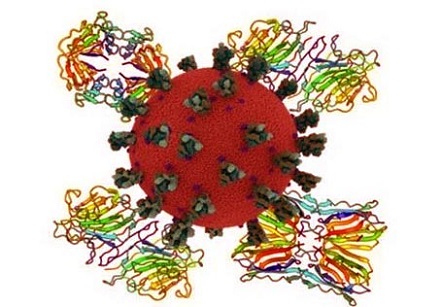Chitra Varughese Fact checked by:Thailand Medical News Team Sep 12, 2024 7 months, 2 weeks, 7 hours, 4 minutes ago
Medical News: A recent study, conducted by researchers from the CSIR-Institute of Microbial Technology in India, delves into the intricate glycosylation patterns of the SARS-CoV-2 Spike protein and how various lectins interact with these glycan structures. Lectins, which are naturally occurring glycoproteins, can bind to specific glycans on viral surfaces, potentially inhibiting the virus's ability to infect host cells. This
Medical News report highlights key findings from the research, which could pave the way for new antiviral treatments targeting COVID-19.
 Exploring how Lectins could unlock new treatments for COVID-19
The Role of Glycosylation in SARS-CoV-2 Infectivity
Exploring how Lectins could unlock new treatments for COVID-19
The Role of Glycosylation in SARS-CoV-2 Infectivity
The Spike glycoprotein on the SARS-CoV-2 virus plays a critical role in viral entry into host cells by binding to the ACE2 receptor. However, what makes the Spike protein even more interesting is its heavy glycosylation - an essential feature that influences both viral infectivity and immune evasion. The glycosylation of the Spike protein not only shields the virus from immune detection but also stabilizes its structure for optimal receptor binding.
According to the researchers, the Spike protein contains 66 N-linked glycosylation sites and several O-glycan sites, with different glycan structures. These glycan shields comprise high mannose, complex-type, and hybrid glycans. The glycosylation sites at N331 and N343 within the receptor-binding domain (RBD) are especially significant for viral infectivity. These glycans are key players in how the virus binds to host cells.
The study highlights the importance of understanding these glycosylation sites in developing therapeutic strategies aimed at blocking viral entry and transmission.
The Power of Lectins in Binding to SARS-CoV-2
Lectins, glycoproteins that can recognize and bind to specific sugar molecules on cell surfaces, offer a potential means of halting viral infections. In this study, the researchers explored the binding interactions between a diverse range of lectins and the SARS-CoV-2 Spike protein. Utilizing a comprehensive array of 95 different lectins, they tested the lectins’ ability to bind to the Spike protein expressed from HEK293F cells and the full SARS-CoV-2 virus cultured from Vero E6 cells.
The study identified several key lectins that showed strong binding affinity to the Spike glycoprotein. Among the most notable were AMA, ASA, BANLEC, GNA, HHA, and PHA-L, which bound to N-glycan core structures on the Spike protein. These lectins exhibited a strong interaction with high-mannose and complex-type glycans, key components of the viral glycan shield. Some lectins, including ACL and SBA, were also found to bind to O-glycan structures present on the Spike protein.
In particular, BANLEC, a banana-derived lectin, demonstrated exceptional binding capacity. BANLEC has already been identified as having potent antiviral properties, and its strong affinity for SARS-CoV-2 glycans suggests that it could be a promising candidate for further antiviral research.
ng>Spike Protein vs. Cultured Virus: The Glycan Differences
The researchers also conducted a comparative analysis between the glycosylation of the recombinant Spike protein and the full SARS-CoV-2 virus. They discovered differences in the glycan structures between the Spike protein produced in laboratory conditions and the virus cultured from Vero E6 cells. Lectins such as PA-IIL, STL, and CPA, which bound strongly to the cultured virus, did not exhibit the same level of binding to the recombinant Spike protein.
This discrepancy points to variations in the glycan profiles of the Spike protein versus the whole virus, possibly due to the different cell lines used for their production. The glycan shield on the cultured virus appears to have more complex glycans, while the recombinant Spike protein contains a higher proportion of high-mannose glycans. These findings emphasize the importance of studying both the isolated Spike protein and the full virus to obtain a complete understanding of viral glycosylation.
Implications for Therapeutic Development
The discovery of lectins that bind strongly to the Spike protein of SARS-CoV-2 opens up new avenues for developing antiviral therapeutics. Since lectins can interfere with viral entry by binding to glycan structures, they could serve as potential inhibitors to block the virus from infecting human cells. Some of the top-binding lectins identified in this study, such as BANLEC and GNA, have already shown antiviral activity against other viruses, including SARS-CoV and HIV.
Future research could focus on harnessing the binding properties of these lectins to develop antiviral agents that specifically target SARS-CoV-2. Lectin-based therapies could complement vaccines and other antiviral drugs by offering an additional layer of protection against the virus, particularly in individuals who are immunocompromised or unable to receive vaccines.
The study also highlights the potential for using lectins in diagnostic applications. By detecting specific glycan signatures on the Spike protein, lectins could be employed in diagnostic assays to identify SARS-CoV-2 infections more accurately.
Conclusion
This comprehensive study has provided valuable insights into the glycan structures of the SARS-CoV-2 Spike protein and how lectins can bind to these structures. By identifying lectins with strong binding affinities, the research has opened new possibilities for therapeutic interventions that target viral glycosylation.
The study findings were published on a preprint server and are currently being peer reviewed.
https://www.researchsquare.com/article/rs-5022883/v1
For the latest COVID-19 News, keep on logging to Thailand Medical News.
Read Also:
https://www.thailandmedical.news/news/breaking-french-study-shows-that-mannose-specific-lectins-from-plants,-fungi,-algae-and-cyanobacteria-can-prevent-various-coronavirus-transmissions-in
https://www.thailandmedical.news/news/chinese-study-finds-that-lectins-derived-from-indian-lentils-or-dhal-exhibit-antiviral-properties-against-the-sars-cov-2-coronavirus-
